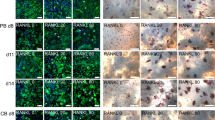Summary
The osteoclast may be of hematopoietic lineage and as such its development could be regulated by colony-stimulating factors. Since there is much interest as to whether osteoblasts influence bone resorption, we examined whether bone cells produce colony-stimulating activity. Both cells isolated from neonatal calvaria and the osteogenic cell MC3T3-E1 were found to constitutively release a colony-stimulating activity possessing characteristics of a macrophage colony-stimulating factor, as determined by basic biochemical purification and by identity of colonies induced in cultures of bone marrow cells. Release could be increased by the presence of the bone-resorbing agents lipopolysaccharide and 1,25 dihydroxyvitamin D3. We conclude that the osteoblast may contribute to both the processes of osteoclast formation and of hematopoiesis through the secretion of colony-stimulating activity into the adjacent bone marrow.
Similar content being viewed by others
References
Walker DG (1972) Congenital osteopetrosis in mice cured by parabiotic union with normal siblings. Endocrinology 91:916–920
Göthlin G, Ericsson JLE (1973) On the histogenesis of cells in fracture callus. Electron microscopic autoradiographic observations in parabiotic rats and studies on labeled monocytes. Virchows Archiv Cell Pathol 12:318–329
Loutit JF, Sanson JM (1976) Osteopetrosis of the microphthalmic mouse: a defect of the haemopoietic stem cell? Calcif Tissue Res 20:251–259
Kahn AJ, Simmons DJ (1975) Investigations of cell lineage in bone using a chimaera of chick and quail embryonic tissue. Nature 258:325–327
Matcalf D (1984) The hemopoietic colony-stimulating factors. Elsevier, Amsterdam, pp 277–307
Burger EH, Van Der JWM, Van De Gevel JS, Gribnau JC, Thesingh CW, Van Furth R (1982) In vitro formation of osteoclasts from long-term cultures of bone marrow mononuclear phagocytes. J Exp Med 156:1604–1614
Burger EH, Van der Meer JWM, Nijweide PJ (1984) Osteoclast formation from mononuclear phagocytes: role of bone-forming cells. J Cell Biol 99:1901–1906
Macdonald BR, Mundy GR, Clark S, Wang EA, Kuehl TJ, Stanley ER, Roodman GD (1986) Effects of human recombinant CSF-GM and highly purified CSF-1 on the formation of multinucleated cells with osteoclast characteristics in longterm bone marrow cultures. J Bone Min Res 1:227–233
Chan SH, Metcalf D (1972) Local production of colony-stimulating factor within the bone marrow: role of nonhematopoietic cells. Blood 40:646–653
Nicola NA, Burgess AW, Metcalf D (1979) Similar molecular properties of granulocyte macrophage colony-stimulating factors produced by different mouse organs in vitro and in vivo. J Biol Chem 254:5290–5299
Shiina-Ishimi Y, Abe E, Tanaka H, Suda T (1986) Synthesis of colony-stimulating factor (CSF) and differentiation-inducing factor (D-factor) by osteoblastic cells, clone MC3T3-E1. Biochem Biophys Res Comm 134:400–406
Luben RA, Wong GL, Cohn DV (1976) Biochemical characterization with parathormone and calcitonin of isolated bone cells: provisional identification of osteoclasts and osteoblasts. Endocrinology 99:526–534
Felix R, Fleisch H (1979) Increase in alkaline phosphatase activity in calvaria cells cultured with diphosphonates. Biochem J 183:73–81
Brown BL, Albano J, Ekins R, Sgherzi A, Tampion W (1971) A simple and sensitive saturation assay method for the measurement of adenosine 3′∶5′-cyclic monophosphate. Biochem J 121:561–562
Kodama H, Amagai Y, Sudo H, Kasai S, Yamamoto S (1981) Establishment of a clonal osteogenic cell line from newborn mouse calvaria. Jpn J Oral Biol 23:899–901
Neumann C, Sorg C (1980) Sequential expression of functions during macrophage differentiation in murine bone marrow liquid culture. Eur J Immunol 10:834–840
Hume DA, Gordon S (1983) Optimal conditions for proliferation of bone marrow-derived mouse macrophages in culture: the roles of CSF-1, serum, Ca2+ and adherence. J Cell Physiol 117:189–194
Cooper PH, Mayer P, Baggiolini M (1984) Stimulation of phagocytosis in bone marrow-derived macrophages by bacterial lipopolysaccharide; correlation with biochemical and functional parameters. J Immunol 133:913–922
Cecchini MG, Felix R, Fleisch H, Cooper PH (in press) Effect of bisphosphonates on proliferation and viability of mouse bone marrow-derived macrophages. J Bone Min Res
Stadler BM, Oppenheim JJ (1982) Human interleukin 2: biological studies using purified IL 2 and monoclonal anti-IL 2 antibodies. In: Mizel SB (ed) Lymphokines, Vol. 6. Academic Press, New York, pp 117–135
Lanotte M (1984) Terminal differentiation of hemopoietic cell clones cultured in tridimensional collagen matrix: in situ cell morphology and enzyme histochemistry analysis. Biol Cell 50:107–120
Stanley ER, Bradley TR, Sumner MA (1971) Properties of the mouse embryo conditioned medium factor(s) stimulating colony formation by mouse bone marrow cells grown in vitro. J Cell Physiol 78:301–318
Stanley ER (1985) The macrophage colony-stimulating factor, CSF-1. In: Methods in enzymology, Vol. 116. Academic Press, New York, p 564–587
Marshall MJ, Nisbet NW, Green PM (1986) Evidence for osteoclast production in mixed bone cell culture. Calcif Tissue Int 38:268–274
Raisz LG, Alander C, Eilon G, Whitehead SP, Nuki K (1982) Effects of two bacterial products, muramyl dipeptide and endotoxin, on bone resorption in organ culture. Calcif Tissue Int 34:365–369
Reynolds J, Holick MF, Deluca HF (1973) The role of vitamin D metabolites in bone resorption. Calcif Tissue Res 12:295–301
Gong JK (1978) Endosteal marrow: a rich source of hematopoietic stem cells. Science 199:1443–1445
Frassoni F, Testa NG, Lord BI (1982) The relative spatial distribution of erythroid progenitor cells in the normal mouse femur. Cell Tissue Kinet 15:447–455
Lord BI, Testa NG, Hendry JH (1975) The relative spatial distributions of CFUs and CFUc in the normal mouse femur. Blood 46:65–72
Author information
Authors and Affiliations
Rights and permissions
About this article
Cite this article
Elford, P.R., Felix, R., Cecchini, M. et al. Murine osteoblastlike cells and the osteogenic cell MC3T3-E1 release a macrophage colony-stimulating activity in culture. Calcif Tissue Int 41, 151–156 (1987). https://doi.org/10.1007/BF02563795
Received:
Revised:
Issue Date:
DOI: https://doi.org/10.1007/BF02563795




